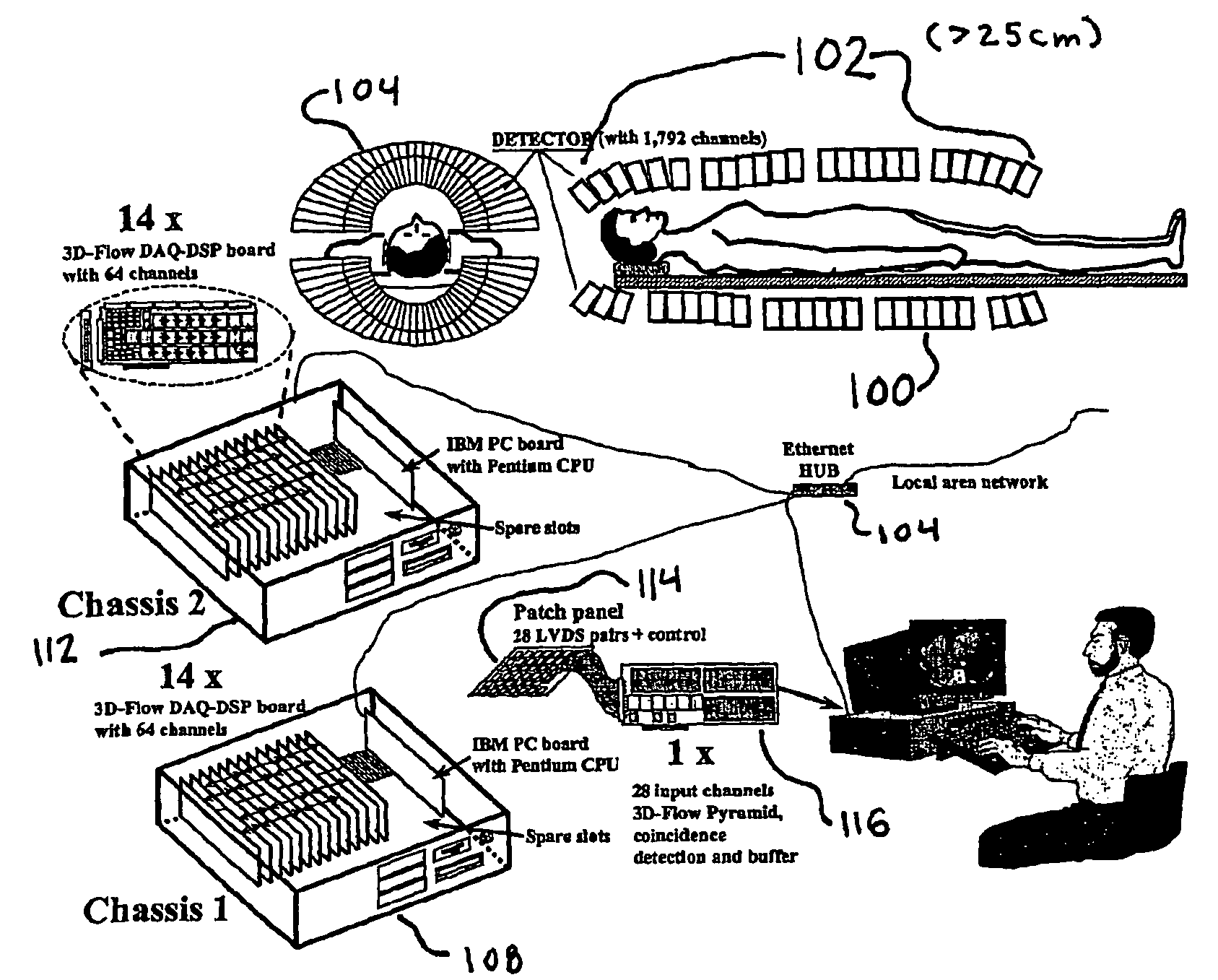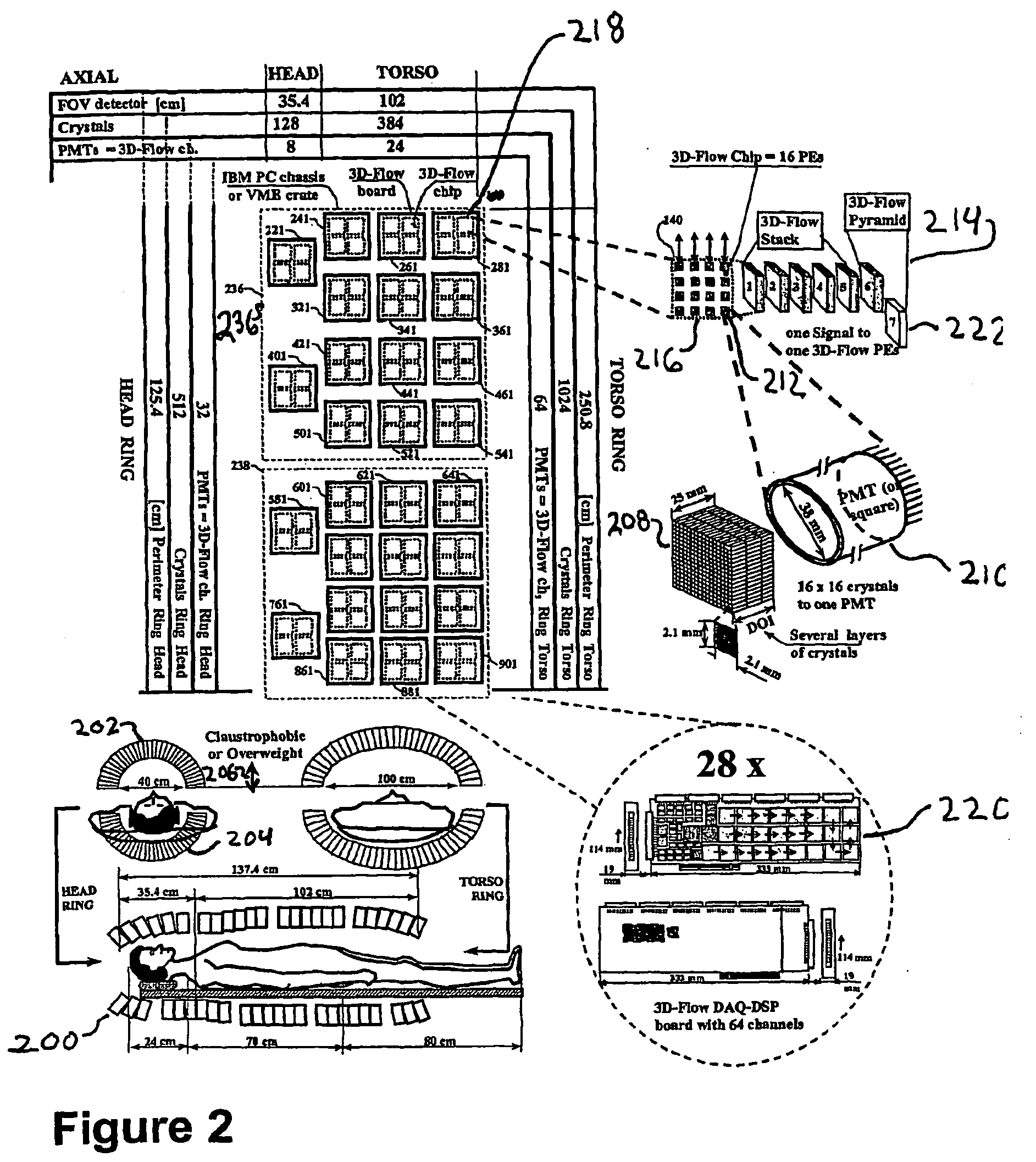The advent of PET in the last 25 years has not had a striking
impact in hospital practice and has not been widely used because the
electronics with the capability of fully exploiting the superiority of the PET technique has never been designed.
Efficient electronics at the front end can identify some Compton scatter events by accurately measuring the energy and the
time of arrival of the photons, however, other Compton scatter events can only be identified after acquisition during the image reconstruction phase.
Low efficiency in detecting photons without the capability of fully extracting the
photon's properties gives poor images that cannot show small tumors, making the device unsuitable for
early detection.
In addition, it requires
high radiation to the patient, which prevents annual examination; and it requires more imaging time, which limits its use to fewer patients per hour, driving the examination cost very high.
This is used to limit the number of photons hitting the
detector (in particular for
body scan where
Compton scattering is more numerous than in a smaller volume head-scan) because the electronics cannot
handle the unregulated rate of photons hitting the
detector.
The real-time
algorithm of current PET cannot thoroughly process all the information necessary to separate a good event from bad events.
Using the current CTI / Siemens and GE approach, the complexity of the electronics would increase enormously, or, alternatively, one would have to drop many photons from being checked.
In that case, however, no significant
advantage is provided to the patient, because the
radiation and the cost have not been lowered.
Although the CT images are of good quality at the expenses of a relatively high x-
ray beam (which should be lowered in order to lower the risk to the patient), the PET images are of
poor quality because only a few emitted photons from the patient's body are captured by the
PET detector.
Other deficiencies of the current PET machines are: low coverage of the entire body, false positives,
high radiation dose, slow scanning, high examination costs.
a. a short FOV, limited by a non efficient electronics that do not offset the cost of the
detector if the FOV were increased (see also next section about the false positive and false negatives);
b. no accurate time-stamp assigned to each
photon (a) limiting the detection of neighboring photons emitted within a short time interval, (b) causing long dead-time of the electronics and (c) increasing randoms.sup.1, (most PETs do not have any
photon time-stamp assignment); .sup.1Randoms are photons in time
coincidence belonging to two different events.
c.
analog signal processing on the front-end electronics limiting photon identification because of poor extraction of the characteristics of the incident photon and absence of the capability to improve
signal-to-
noise (S / N) ratio;
d. detector boundary limitation to 2.times.2 PMT blocks, no correlation between signals from neighboring detector blocks, no full energy reconstruction of the photons that hit the detector, (most of current PET do not attempt to make any energy reconstruction of the event, but take decisions in accepting or rejecting first a photon and later an
event based on the threshold of a single
signal).
e. dead-time of the electronics. Dead-time of the electronics is due to any
bottleneck (e.g.,
multiplexing of data from many lines to a
single line, saturation on input,
processing, saturation on output) present at any stage of the electronics.
f. saturation of the electronics at the input stage due to its inability to detect and process two nearby photons that hit the detector within a short time interval;
g. costly and inefficient
coincidence detection circuit (most current PET [20], [18] have a
coincidence detection circuit that tests for coincidence all possible combinations of the
Lines of Response (LOR) passing through the patient's body).
Although current PET have made a compromise in coincidence detection efficiency versus
circuit complexity, by using a coarse segmentation of the detector in order to reduce the number of LOR to be tested for coincidence, that approach is however an impediment to increasing the FOV.
This approach adds unnecessary complexity to the electronics of the current PET and makes it unreasonably costly to build a circuit with an acceptable efficiency when more detector elements are added to the detector (which is required in extending the FOV);
j. Poor measurement of the attenuation of different tissues at different locations in a patient's body.
The short FOV and the inefficient electronics allow to accumulate fewer than 2 photons in coincidence every 10,000 emitted.
This inefficiency requires to administer necessarily
high radiation dosage to the patient in order to keep the examination time within an hour.
4. The slow scanning time is because of the short FOV of the current PET and of the low efficiency of the electronics.
The limited efficiency mentioned above of 2 out of 10,000 requires long
acquisition time.
Examinations longer than one bout are unacceptable because (a) the
biological process desired to observe and the radioisotope decay activity would be over, (b) the patient would be uncomfortable, and (c) the cost would be even higher that what it already is;
5. The current high cost of the examination is due to:
the high cost of the huge
dose of radioisotope required;
the cost of highly paid personnel who must operate the slow
machine.
 Login to View More
Login to View More  Login to View More
Login to View More 


